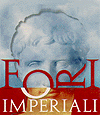Roman
numeration
The Romans counted according to decimal
mathematics, just like we do, but with a different style of writing. It is useful to know
this method of writing because we still run across these numbers today. So here is a
layout of the numbers so we can remember them.
Numeration
Utilized were only 7 alphabetical symbols to form
all numbers, placed before or after a symbol to subtract or sum among them. A small bar
above the letter adds 1,000 of the expressed value. Zero has no symbol.
I = 1
V = 5
X = 10
L = 50
C = 100
D = 500
M = 1.000
When two letters (numbers) are adjacent; if the
lesser number is to the right it is added to that of the left, while if the lesser is to
the left, it is subtracted from that on the right. Therefore, VI = 6 and IV = 4. Exception
are rare.
Some rules have been added as follows: 3 identical symbols are never attached (and never
repeat V or L), a lesser number must proceed a larger one that is a maximum of ten times
the difference of the previous number (so today we are in MCMXCIX and not MIM).
Vocal correspondence of the cardinal
numbers
1
|
unus
|
19
|
undeviginti
|
2
|
duo
|
20
|
viginti
|
3
|
tres
|
30
|
triginta
|
4
|
quattuor
|
40
|
quadraginta
|
5
|
quinque
|
50
|
quinquaginta
|
6
|
sex
|
60
|
sexaginta
|
7
|
septem
|
70
|
septuaginta
|
8
|
octo
|
80
|
octoginta
|
9
|
novem
|
90
|
nonaginta
|
10
|
decem
|
100
|
centum
|
11
|
undecim
|
200
|
ducenti
|
12
|
duodecim
|
300
|
trecenti
|
13
|
tredecim
|
400
|
quadrigenti
|
14
|
quattuordecim
|
500
|
quingenti
|
15
|
quindecim
|
600
|
sescenti
|
16
|
sedecim
|
700
|
septingenti
|
17
|
septendecim
|
800
|
octingenti
|
18
|
duodeviginti
|
900
|
nongenti
|
|
|
1000
|
mille
|
The declination of numbers
|
Masculine |
Feminine |
Neutral |
| Name |
unus |
una |
unum |
| Genitive |
unius |
unius |
unius |
| Dative |
uni |
uni |
uni |
| Accusative |
unum |
unam |
unum |
| Ablative |
uno |
una |
uno |
|
Masculine |
Feminine |
Neutral |
| Name |
duo |
duae |
duo |
| Genitive |
duorum |
duarum |
duorum |
| Dative |
duobus |
duabus |
duobus |
| Accusative |
duos |
duas |
duo |
| Ablative |
duobus |
duabus |
duobus |
|
Masculine |
Feminine |
Neutral |
| Name |
tres |
tria |
|
| Genitive |
trium |
trium |
|
| Dative |
tribus |
tribus |
|
| Accusative |
tres |
tria |
|
| Ablative |
tribus |
tribus |
|
- 2000 = duo milia
- 3000 = tria milia
- 4000 = quattuor milia
Hours of the day
The primitive Romans didn't have the possibility
to exactly measure the time and based the hour principally on the rising, the position,
and the setting of the sun. Only three moments were defined: the dawn ("solis
Ortus"), noon ("meridies"), and dusk ("solis occasus"). The day
was divided into two parts: morning ("ante Meridiem") and evening ("post
meridium"), still used today in the English language as AM/PM.
In 263 B.C. the sundial ("solarium") was introduced in Sicily and installed in
the Forum area. This allowed the day to be divided into 12 numbered hours
("horae"), followed by a.m. or p.m., with each hour divided into 60 minutes.
The hourglass ("clepsydra") followed this, also called the
"horologium". This was used by the military to divide the guard's
("vigilae") shifts.
> Celebrated sayings and
proverbs
> Calendar of Roman
holidays
> Quiz for visiting the
Imperial Forums
> Antique Rome in the
modern cinema
In the other chapters you can find news on the
advancement in archeological excavation in the Imperial Forum area, the history of Rome,
and the daily life and habits of the Antique Romans. Select a chapter from the four titles
in the black column on the right.
|



